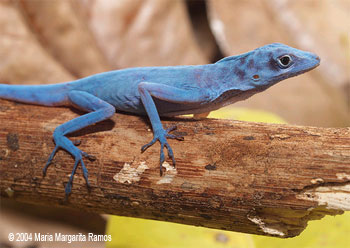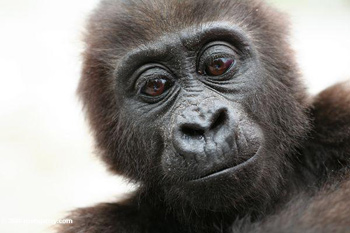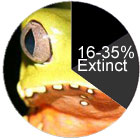16,306 species threatened with extinction
16,306 species threatened with extinction
mongabay.com
September 12, 2007
40% of species assessed by IUCN are threatened with extinction. New tally represents a 1.2 percent increase (187 species) in listed species since 2006 update
16,306 of 41,415 species on the IUCN Red List are threatened with extinction, reports the World Conservation Union (IUCN). The total number of known extinct species now stands at 785, while a further 65 are only found in captivity or in cultivation. One in four mammals, one in eight birds, one third of all amphibians and 70% of the world’s assessed plants on the 2007 IUCN Red List are considered at risk.
“This year’s IUCN Red List shows that the invaluable efforts made so far to protect species are not enough,” said Julia Marton-Lefèvre, Director General of the World Conservation Union (IUCN). “The rate of biodiversity loss is increasing and we need to act now to significantly reduce it and stave off this global extinction crisis. This can be done, but only with a concerted effort by all levels of society.”
The IUCN Red List is considered the most authoritative assessment of the global status of plants and animals. It classifies species according to their extinction risk and is available online as a searchable database.
 The blue anole, a threatened species on Isla Gorgona in Colombia. Photo by Maria Margarita Ramos
Related articles
Biodiversity extinction crisis looms says renowned biologist
Just how bad is the biodiversity extinction crisis? Extinction, like climate change, is complicated European blood-sucker falls victim to global warming Climate change claims a snail |
“We need to know the precise status of species in order to take the appropriate action. The IUCN Red List does this by measuring the overall status of biodiversity, the rate at which it is being lost and the causes of decline,” said Jane Smart, Head of IUCN’s Species Programme. “Our lives are inextricably linked with biodiversity and ultimately its protection is essential for our very survival. As the world begins to respond to the current crisis of biodiversity loss, the information from the IUCN Red List is needed to design and implement effective conservation strategies — for the benefit of people and nature.”
For the 2007 Red List update, IUCN highlighted the continuing decline of several groups including the great apes, the baiji, and vultures. The organization added corals to the list for the first time.
Among the great apes, the Western Gorilla (Gorilla gorilla) saw the biggest change in status, moving from Endangered to Critically Endangered, after the discovery that the main subspecies, the Western Lowland Gorilla (Gorilla gorilla gorilla), has been hard hit by the commercial bushmeat trade and the Ebola virus. IUCN said that their population has declined by more than 60% over the last two decades, with about one third of the total population found in protected areas killed by the Ebola virus over the last 15 years. In Asia, IUCN notes that the Sumatran Orangutan (Pongo abelii) remains in the Critically Endangered category and the Bornean Orangutan (Pongo pygmaeus) in the Endangered category. Both species are threatened by habitat loss due to illegal and legal logging, forest fires, poaching, and forest clearance for palm oil plantations. The U.N. Environment Program (UNEP) warns that 98 percent of orangutan habitat will be gone by 2022.
The organization said that five species of vulture have reclassified on the IUCN Red List as the birds are increasingly poisoned by the use of diclofenac, a drug used to treat livestock to kill livestock predators. IUCN said that populations are further declining from reduction in wild grazing mammals, habitat loss and collision with power lines.
Among aquatic species, IUCN acknowledged the likely disappearance of the Yangtze river dolphin, or baiji, after extensive surveys failed to produce a single dolphin. While a sighting was reported in August and is currently being investigated, the outlook is poor for the species. Should its extinction be confirmed, the baiji would be the first large aquatic mammal to disappear since the Caribbean monk seal in the 1950s.
IUCN said the aquarium trade is taking a toll on the Banggai Cardinalfish (Pterapogon kauderni), which was added to the list for the first time. IUCN estimates that 900,000 Banggai Cardinalfish are extracted from their habitat in the Banggai Archipelago, near Sulawesi, Indonesia every year.
IUCN said that only a single species has moved to a lower category of endangerment: The Mauritius Echo Parakeet (Psittacula eques), which moved from Critically Endangered to Endangered. IUCN attributes the improvement to successful conservation action, including close monitoring of nesting sites and supplementary feeding combined with a captive breeding and release program.
“From previous experience, we know that conservation can work, but unfortunately this year we are documenting an improvement for only one species,” Jean-Christophe Vié, Deputy Head of IUCN’s Species Programme. “This is really worrying in light of government commitments around the world, such as the 2010 target to slow down the rate of biodiversity loss. Clearly, this shows that much more needs to be done to support the work of thousands of enthusiastic people working everyday throughout the world to preserve the diversity of life on this planet.”
“Conservation networks dedicated to fighting the extinction crisis, such as the Species Survival Commission, are working effectively. But much more help and support is needed as environmentalists cannot do it alone,” Holly Dublin, Chair of IUCN’s Species Survival Commission, added. “The challenge of the extinction crisis also requires attention and action from the general public, the private sector, governments and policy makers to ensure that global biodiversity remains intact for generations to come.”
Many scientists say Earth is presently in the midst of a sixth great extinction, the Holocene. Unlike previous mass extinctions in the past — the Ordovician, the Devonian, the Permian, the Triassic and the Cretaceous — the current extinction event results directly from human activities, including habitat destruction, overexploitation, and the introduction of alien species to environments where they do not occur naturally. Scientists estimate that extinction rates are presently 1,000-10,000 times the historical background rate of about 1 species per million per year. They say that extinction rates will significantly increase in coming years, especially as the impacts of climate change intensify.
More articles on extinction


